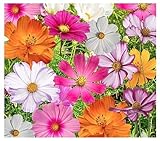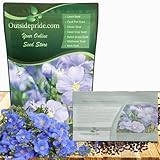The Best seeds planted in concrete of 2022 – Reviewed and Top Rated
After hours researching and comparing all models on the market, we find out the Best seeds planted in concrete of 2022. Check our ranking below.
2,891 Reviews Scanned
- Sparacino, Bianca (Author)
- English (Publication Language)
- 122 Pages - 10/05/2018 (Publication Date) - Thought Catalog Books (Publisher)
- VIBRANT PURPLE BLOOMS – Stunning Flowering Ground Cover Perennial. Aubrieta Rock Cress grows 3-4 inches high filling gardens with vivid purple blooms, thriving on slopes, rocky spaces, and borders. A stunning choice to add a pop of color and a resilient flowering ground cover.
- DROUGHT TOLERANT BEAUTY – Thrives in Harsh Conditions. This drought tolerant ground cover aubretia plant flourishes in rocky soils with little water. Ideal for xeriscaping and resilient landscapes with a cascading flower charm.
- LOW GROWING ELEGANCE – Perfect for Tight Spaces. Sow low growing ground cover seeds between pavers or walls. Aubrieta grows into lush mats with vibrant blooms, creating the look gardeners love for walls and slopes.
- NATURAL EROSION CONTROL – Stabilizes Slopes and Walls. Ground cover flower seeds like Aubrieta provide lush, mat-forming plants that anchor soil. Great for erosion control, rocky slopes, and steep areas with reliable perennial ground cover.
- PERENNIAL POWERHOUSE – Grows Back Year After Year. This perennial ground cover returns each spring with vibrant blooms. Aubrieta plants create colorful landscapes season after season, offering easy beauty for busy gardeners everywhere.
- Cosmos Collection of 11 Varieties - Seeds
- Easy to Grow Annual in All Zones, As the seeds do not need light to germinate, they can be sown directly or covered with 1/4 inch of soil.
- Sow your Cosmos seeds in the Full Sun to Partial Shade. As cosmos flowers are very adaptable, they can thrive in average to poor soil quality, and they are tolerant to dry conditions.
- Because of their Mexican heritage, these bright annuals meet high heat and drought conditions with native beauty and vigor. Spanish conquistadors searching for gold discovered these flowers on their journeys through Mexico. Mission gardens often included these flowers, which priests gave the name "cosmos," the Greek word for a harmonious whole, because of their neatly spaced petals. Cosmos flowers made their way to England with Spanish ambassadors in the late 18th century.
- Non GMO and Neonicotinoid Seed. Marde Ross & Company has been a Licensed California Nursery Since 1985,
- DAZZLING BLOOMS WITH LONG BLOOM PERIOD: Our flax flowers bloom in light blue adding vibrant color during spring and summer. Growing 12 - 24 inches tall, they create a stunning display in borders, meadows, and naturalized landscapes. Their delicate, swaying blooms add movement and texture to any outdoor space, making them a standout choice.
- ADAPTS WELL TO VARIOUS CLIMATES (USDA ZONES 3 - 10): Suitable for a wide range of growing zones, our perennial plants thrive in cool and warm regions alike. They reseed naturally, ensuring continued growth with minimal effort. Their adaptability makes them a suitable option of flower seeds to plant outside, ideal for home gardens, naturalized landscapes, and large-scale plantings.
- DROUGHT-TOLERANT FOR LOW-MAINTENANCE GARDENS: Our flax plants prefer full sun and withstand hot, dry weather once established. They require little watering, making them useful for xeriscape gardens, rock gardens, and water-wise landscapes while continuing to produce colorful, delicate blooms that add texture and vibrancy throughout the season.
- ATTRACTS POLLINATORS & DEER-PROOF: Our flax flowers are bee, butterfly, and bird-friendly, supporting biodiversity while keeping deer away from grazing. Growing in well-drained soil, they provide seasonal beauty and help create a thriving pollinator garden filled with vibrant wildlife, making them a beneficial addition to mixed flower beds.
- EASY TO PLANT & FAST TO GROW: Direct sow our flax wildflower seeds outdoors in early spring when temperatures reach 65 - 70°F. Lightly rake soil over seeds and keep moist until germination in 20 - 30 days. Space plants 12 - 18 inches apart for healthy growth, with sowing rates of 4 ounces per 1,000 sq. ft. or 9 - 17 pounds per acre, depending on variety and coverage needs.
- SKY-BLUE BLOSSOMS – Forget me not seeds grow 6-12” tall and produce clusters of delicate ¼” blue flowers with yellow centers, blooming from spring to summer. Beautiful around tulips, bulbs, or weaving through borders for soft color.
- GUARANTEED TO GERMINATE – Our seeds are carefully kept in temperature-controlled refrigeration, preserving peak freshness to support reliable germination and strong, healthy plant starts.
- EASY TO SOW – Scatter forget me not seeds in fall or early spring in partial shade or sun. Grow in moist, well-drained soil. Germinate in 10-20 days. Hardy in zones 3-9. Pack contains 5,000 seeds.
- QUALITY SEEDS FROM MARDE ROSS & COMPANY – A trusted California nursery since 1985, we offer the finest untreated forget me not seeds, ensuring reliable germination and beautiful blue blooms season after season.
- EARLY BLOOMS THAT FEED POLLINATORS – Forget me nots bloom in partial shade, filling nectar gaps when few flowers grow. Vital for bees and butterflies emerging in early spring, helping to sustain pollinators as the season begins.
- English (Publication Language)
- 09/15/2018 (Publication Date) - Thought Catalog Books (Publisher)
- Mixed Colors Moss Verbena performs well in hot, dry conditions and makes an excellent ground cover. The color mix includes pink, purple, red, rose and white. SCIENTIFIC NAME Verbena tenuisecta.
- Great Ground Cover Allow Bulbs Like Tulips to Grow Up Through the Plants
- Full Sun. Takes moderately conditions. Sow in Spring or Late Fall when Soil is Warm
- Tender Perennial that Blooms in Summer and Fall.
- Marde Ross & Company has been a licensed California Nursery since 1985
- Botanical Overview: Purple rockcress (Aubrieta deltoidea) is a perennial plant known for its vibrant, purple-pink flowers. It is native to western North America, particularly thriving in rocky or mountainous terrains.
- Appearance and Growth: This plant features rosettes of basal leaves, with flowering stems that can grow up to 12 inches tall. The leaves are lance-shaped and often have a grayish-green hue, with the plant producing an abundance of small, cross-shaped flowers in spring.
- Ecological Role: Purple rockcress is crucial in its native habitat for soil stabilization on rocky slopes and cliffs. It's also a valuable nectar source for early spring pollinators, including bees and butterflies, contributing to local biodiversity.
- Garden Use: In gardens, purple rockcress is appreciated for its low-maintenance nature and ability to grow in poor, well-drained soils where other plants might struggle. It's ideal for rock gardens, borders, or as ground cover, adding early color and texture to landscapes.
- Quality: All seeds packaged by Seed Needs are intended for the current and the following growing seasons. All seeds are stored in a temperature controlled facility that is free of significant amounts of moisture.
Last update on 2025-08-31 / Affiliate links / Images from Amazon Product Advertising API
How Do You Buy The Best seeds planted in concrete?
Do you get stressed out thinking about shopping for a great seeds planted in concrete? Do doubts keep creeping into your mind? We understand, because we’ve already gone through the whole process of researching seeds planted in concrete, which is why we have assembled a comprehensive list of the greatest seeds planted in concrete available in the current market. We’ve also come up with a list of questions that you probably have yourself.
We’ve done the best we can with our thoughts and recommendations, but it’s still crucial that you do thorough research on your own for seeds planted in concrete that you consider buying. Your questions might include the following:
- Is it worth buying an seeds planted in concrete?
- What benefits are there with buying an seeds planted in concrete?
- What factors deserve consideration when shopping for an effective seeds planted in concrete?
- Why is it crucial to invest in any seeds planted in concrete, much less the best one?
- Which seeds planted in concrete are good in the current market?
- Where can you find information like this about seeds planted in concrete?
We’re convinced that you likely have far more questions than just these regarding seeds planted in concrete, and the only real way to satisfy your need for knowledge is to get information from as many reputable online sources as you possibly can.
Potential sources can include buying guides for seeds planted in concrete, rating websites, word-of-mouth testimonials, online forums, and product reviews. Thorough and mindful research is crucial to making sure you get your hands on the best-possible seeds planted in concrete. Make sure that you are only using trustworthy and credible websites and sources.
We provide an seeds planted in concrete buying guide, and the information is totally objective and authentic. We employ both AI and big data in proofreading the collected information. How did we create this buying guide? We did it using a custom-created selection of algorithms that lets us manifest a top-10 list of the best available seeds planted in concrete currently available on the market.
This technology we use to assemble our list depends on a variety of factors, including but not limited to the following:
- Brand Value: Every brand of seeds planted in concrete has a value all its own. Most brands offer some sort of unique selling proposition that’s supposed to bring something different to the table than their competitors.
- Features: What bells and whistles matter for an seeds planted in concrete?
- Specifications: How powerful they are can be measured.
- Product Value: This simply is how much bang for the buck you get from your seeds planted in concrete.
- Customer Ratings: Number ratings grade seeds planted in concrete objectively.
- Customer Reviews: Closely related to ratings, these paragraphs give you first-hand and detailed information from real-world users about their seeds planted in concrete.
- Product Quality: You don’t always get what you pay for with an seeds planted in concrete, sometimes less, and sometimes more.
- Product Reliability: How sturdy and durable an seeds planted in concrete is should be an indication of how long it will work out for you.
We always remember that maintaining seeds planted in concrete information to stay current is a top priority, which is why we are constantly updating our websites. Learn more about us using online sources.
If you think that anything we present here regarding seeds planted in concrete is irrelevant, incorrect, misleading, or erroneous, then please let us know promptly! We’re here for you all the time. Contact us here. Or You can read more about us to see our vision.
FAQ:
Q: Does seed need soil to germinate?
A: Plants come from seeds. Each seed contains a tiny plant waiting for the right conditions to germinate, or start to grow. Seeds wait to germinate until three needs are met: water, correct temperature (warmth), and a good location (such as in soil).
Q: What is a seed for planting?
A: A seed is an embryonic plant enclosed in a protective outer covering . The formation of the seed is part of the process of reproduction in seed plants, the spermatophytes, including the gymnosperm and angiosperm plants.
Q: What is a concrete plant?
A: A concrete plant, also known as a batch plant or batching plant or a concrete batching plant, is equipment that combines various ingredients to form concrete. Some of these inputs include water, air, admixtures, sand, aggregate (rocks, gravel, etc.), fly ash, silica fume, slag, and cement.









